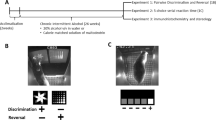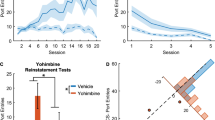Abstract
To test the Pavlovian conditioning model of alcohol tolerance, two groups of eight male social drinkers each received five administrations of alcohol and five administrations of an equal volume of tonic each, on an alternating basis, during the initial 10-session tolerance development phase of the study. Group 1 received alcohol in a “distinct” environment and received tonic in a “home” environment. For group 2, the relationship between environmental cues and substances consumed was reversed. In a subsequent tolerance test session, both groups received alcohol in the distinct environment. When group 2 subjects were tested in this session under cues never before associated with alcohol, they were significantly more impaired on a complex cognitive task than group 1 subjects who expected alcohol; this result was in accord with the classical conditioning model of tolerance. In a final session, both groups received tonic in the distinct environment. As predicted, group 1 exhibited a compensatory enhancement in cognitive performance relative to group 2.
Similar content being viewed by others
References
Bancroft TA (1968) Topics in intermediate statistical methods. The Iowa State University Press, Ames IA
Bandura A (1969) Principles of behavior modification. Holt, Rinehart & Winston, New York, pp 579–584
Bindra D (1976) A theory of intelligent behavior. Wiley, New York, pp 247–250
Crowell CR, Hinson RE, Siegel S (1981) The role of conditional drug responses in tolerance to the hypothermic effects of alcohol. Psychopharmacology 73: 51–54
Dafters R, Anderson G (1982) Conditioned tolerance to the tachycardia effect of ethanol in humans. Psychopharmacology 78: 365–367
Eikelboom R, Stewart J (1982) Conditioning of drug-induced physiological responses. Psychol Rev 89: 507–528
Goldstein A, Arrow L, Kalman SH (1974) Principals of drug action. 2nd ed. John Wiley, New York
Hinson RE, Siegel S (1980) The contribution of Pavlovian conditioning to ethanol tolerance and dependence. In: Righter H, Crabbe JC (eds) The behavioral pharmacology of alcohol tolerance, dependence and addiction: a research handbook. Elsevier/North Holland Biomedical Press, New York
Kalant H, LeBlanc AE, Gibbons RE (1971) Tolerance to and dependence on some non-opiate psychotropic drugs. Pharmacol Rev 23: 135
Lightfoot L, Vogel-Sprott M (1981) Behavioral tolerance to low doses of alcohol in social drinkers. Paper presented at Canadian Psychological Association, Toronto
Lipscomb TR, Nathan PE (1980) The effects of familial history of alcoholism, drinking pattern, and tolerance on blood alcohol level discrimination using internal cues. Arch Gen Psychiatry 37: 577–582
Maisto SA, Connors GJ, Tucker JA, McCollam JB (1980) Validation of a scale measuring physiological response to alcohol. Behav Re Ther 18: 37–43
Mansfield JG, Benedict RS, Woods SC (1983) Response specificity of behaviorally augmented tolerance to ethanol supports a learning interpretation. Psychopharmacology 79: 94–98
Nowlis V (1965) Research with the mood adjective checklist. In: Izard C (ed) Affect, cognition, and personality. Springer, New York
Oates JF, McCoy RT (1973) Laboratory evaluation of alcohol safety interlock systems, vol 3. Report to the highway research institute, National Highway Traffic Safety Administration, Department of Traffic Safety Adminstration, Department of Transportion, Washington, DC
Siegel S (1978) A Pavlovian conditioning analysis of morphine tolerance. In: Krasnegor NA (ed) Behavioral tolerance. NIDA Research Monograph No. 18
Tiffany ST, Petrie EC, Baker TB, Dahl J (1983) Conditioned morphine tolerance in the rat: Absence of a compensatory response and cross-tolerance with stress. Behav Neurosci (in press) 97: 335–353
Vogel-Sprott M (1976) Coding and vigilance under alcohol: repeated tests with low concentrations. J Stud Alcohol 37: 1582–1592
Wenger JR, Tiffany TM, Bombardier C, Nicholls K, Woods SC (1981) Ethanol tolerance in the rat is learned. Science 213: 575–577
Williams RM, Goldman MS, Williams DL (1981) Expectancy and pharmacological effects of alcohol on human cognitive and motor performance: the compensation for alcohol effect. J Abnorm Psychol 90: 267–270
Winer BJ (1971) Statistical principles in experimental design. McGraw-Hill, New York
Author information
Authors and Affiliations
Rights and permissions
About this article
Cite this article
Shapiro, A.P., Nathan, P.E. Human tolerance to alcohol: The role of Pavlovian conditioning processes. Psychopharmacologia 88, 90–95 (1986). https://doi.org/10.1007/BF00310519
Received:
Revised:
Issue Date:
DOI: https://doi.org/10.1007/BF00310519




